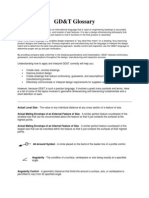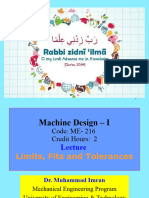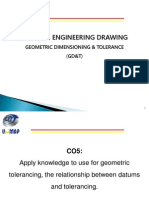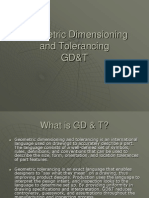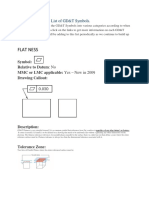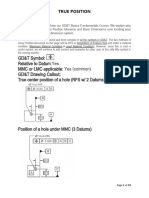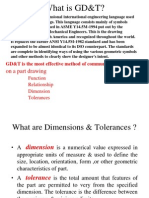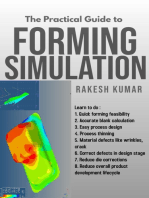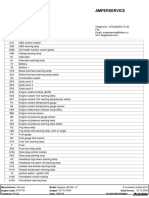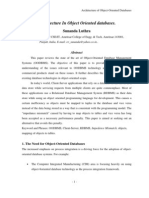Counter Bore
Counter Bore
Uploaded by
SURYA20051961Copyright:
Available Formats
Counter Bore
Counter Bore
Uploaded by
SURYA20051961Copyright
Available Formats
Share this document
Did you find this document useful?
Is this content inappropriate?
Copyright:
Available Formats
Counter Bore
Counter Bore
Uploaded by
SURYA20051961Copyright:
Available Formats
Geometric Dimensioning and Tolerancing (GD&T) is a symbolic language used on mechanical drawings to communicate design requirements.
Engineering, manufacturing, and inspection personnel must all be fluent in this system to make it effective. But it's not as simple as just learning the symbols. GD&T can also be thought of as a design philosophy that integrates the function of the part into the tolerances. Below is a sample GD&T drawing:
The language of geometric dimensioning and tolerancing can be intimidating at first, but when used properly, it can yield many advantages:
y
Standardized, international system
y y y y y y
More flexibility, particularly for complex shapes Allows cylindrical tolerance zones Datums are clearly defined Based on the fit and function of a part or assembly Eliminates the need for many notes Allows for more tolerance
This last benefit of GD&T is surprising to many people; they think that using GD&T will mean tighter tolerances. This concept is one of the first items covered in our GD&T Fundamentals class, using a simple, concrete example. The following is a list of definitions for the most common terms used in GD&T. A more extensive glossary is distributed to each participant in our seminars. Angularity The geometric tolerance used to control a surface, axis, or center plane that is designed to be at a specified angle from a given datum. ASME Y14.5M-1994 Still the predominant standard for dimensioning and tolerancing in North America. It is published by the American Society of Mechanical Engineers, and is available in print book or PDF format. ASME Y14.5-2009 The new standard for dimensioning and tolerancing in North America, released in March of 2009. It features many changes, although most are minor changes in definitions or modifiers to replace previous notes. It is also available in print book or PDF format.
Bonus tolerance An additional tolerance beyond what is given in the feature control frame. This is allowed if the tolerance number is followed by the MMC (or LMC) modifier. The amount of bonus tolerance is determined from the difference between a feature s actual size and the MMC (or LMC). Circularity A geometric tolerance used to control all points on a surface, at any perpendicular cross-section, to be equidistant from the axis. Sometimes referred to as roundness. Concentricity A geometric tolerance used to control the median points of all diametrically opposed elements of a circular feature, in order to be congruent with a datum axis. It is commonly misused; usually runout or position can suffice. Cylindricity A geometric tolerance used to control a surface of revolution (inside or outside diameter) where all points are to be equidistant from a common axis. The cylindricity tolerance will control circularity, straightness, and taper. Datum A theoretically exact point, axis, or plane derived by contact a datum feature; it then becomes the origin from which geometric characteristics are measured. Datum target A specific point, line, or area on a datum feature that is used to establish a datum (rather than using the full feature to establish the datum). Feature control frame The rectangular box that is used to display a geometric tolerance. It is divided into compartments
which identify the geometric characteristic symbol, the tolerance value, and any datum references. Flatness A geometric tolerance used to control a surface which is designed to have all elements in the same plane. Flatness allows variation within two imaginary planes, separated by the given tolerance amount. With the 2009 standard, it may also be used on a centerplane of a feature of size. Geometric dimensioning and tolerancing Affectionately called GD&T, it is a symbolic system of controlling dimensional variation. In addition to providing standardized symbols and rules, it is a design philosophy that ensures that tolerances are based on fit and function. Least material condition A number that represents the condition where a feature of size has the least amount of material, while still being within the given size limits. Thus, LMC would be the smallest pin (for an external feature) or the largest hole (for an internal feature). Maximum material condition Often abbreviated as MMC, the size of a feature of size when it contains the most material allowed (while still being within the acceptable size limits). Parallelism The geometric tolerance used to control a surface, axis, or center plane that is designed to be parallel (zero degrees) in relation to a datum.
Perpendicularity The geometric tolerance used to control a surface, axis, or center plane that is designed to be 90 to a datum. Position A geometric tolerance that controls the location of a feature of size. It defines a zone around the perfect location within which the axis or center plane of the feature is permitted to vary. Profile of a line A geometric tolerance used to control line elements (taken at any cross-section in the plane of the given view) as they relate to the true profile. It may or may not reference datums. Profile of a surface A geometric tolerance used to control a three-dimensional surface as compared to the true profile. It may or may not reference datums. Projected tolerance zone A concept sometimes used in GD&T to indicate that a tolerance zone does not exist within the part itself, but is projected above the part surface. This is usually done to ensure that a fastener will assemble through multiple parts without interference. Regardless of feature size Abbreviated RFS, it is a term used to indicate that a geometric tolerance is the same, no matter what size the feature is made at. It is the presumed condition, unless the symbol for MMC or LMC is shown. Resultant condition A number, similar to virtual condition, that represents the worst-case combination of size and
geometric tolerance. However, instead of representing the mating size, this shows how much material may be affected. Rule #1 The rule defined in the ASME standard stating that a size dimension, for a feature of size on a rigid part, not only controls the size, but also the form. Rule #2 The rule in the ASME standard stating that all geometric tolerances are assumed to be RFS unless the modifier for MMC or LMC is shown. This applies to the tolerance value and any datum references that are features of size. Runout The category of geometric tolerancing that controls a surface of revolution as compared to a datum axis other than its own. It can be used to control circularity, wobble, taper, and concentricity. The two types of runout are circular runout and total runout. Shift tolerance Also called datum shift, this refers to the looseness or play that is sometimes allowed on a datum feature. Similar to bonus tolerance, it is the result of using a modifier (usually MMC) after the datum reference in a feature control frame. Straightness The geometric tolerance applied to an axis or surface element which is designed to be perfectly straight. It may be applied to a surface (individual elements) or a feature of size (axis or centerplane).
Symmetry The geometric tolerance used to control the median points of all opposed elements of two or more feature surfaces to be congruent with a datum axis or plane. It is commonly misused; usually position will suffice. Virtual condition A number that represents the worst-case mating size for an individual feature. It represents the combined effect of a feature s size tolerance and the geometric tolerance.
Counterbored Holes Dimensions (metric)
METRIC SOCKET-HEAD CAP SCREWS CLEARANCE CLEARANCE SCREW COUNTERBORE COUNTERBORE COUNTERSINK DIA DIA (CLOSE DIA DIA DEPTH DIA (NORMAL FIT) FIT) M1,6 M2 M2,5 M3 M4 M5 M6 M8 M10 M12 M14 M16 M20 M24 M30 M36 M42 M48 3,50mm 4,40mm 5,40mm 6,50mm 8,25mm 9,75mm 11,20mm 14,50mm 17,50mm 19,50mm 22,50mm 25,50mm 31,50mm 37,50mm 47,50mm 56,50mm 66,00mm 75,00mm 1,6mm 2mm 2,5mm 3mm 4mm 5mm 6mm 8mm 10mm 12mm 14mm 16mm 20mm 24mm 30mm 36mm 42mm 28mm 2,0mm 2,6mm 3,1mm 3,6mm 4,7mm 5,7mm 6,8mm 9,2mm 11,2mm 14,2mm 16,2mm 18,2mm 22,4mm 26,4mm 33,4mm 39,4mm 45,6mm 52,6mm 1,95mm 2,40mm 3,00mm 3,70mm 4,80mm 5,80mm 6,80mm 8,80mm 10,80mm 13,00mm 15,00mm 17,00mm 21,00mm 25,00mm 31,50mm 37,50mm 44,00mm 50,00mm 1,80mm 2,20mm 2,70mm 3,40mm 4,40mm 5,40mm 6,40mm 8,40mm 10,50mm 12,50mm 14,50mm 16,50mm 20,50mm 24,50mm 31,00mm 37,00mm 43,00mm 49,00mm
Counterbored Holes for Socket-Head Cap Screws (USA)
D A B C SCREW CLEARANCE DIA COUNTERBORE COUNTERBORE COUNTERSINK DIA DIA DEPTH DIA NORMAL FIT CLOSE FIT #0 #2 #4 #5 #6 #8 #10 1/4 5/16 3/8 7/16 1/2 5/8 3/4 7/8 1/8 3/16 7/32 1/4 9/32 5/16 3/8 7/16 17/32 5/8 23/32 13/16 1 1-3/16 1-3/8 .060 .086 .112 .125 .138 .164 .190 .250 .312 .375 .438 .500 .625 .750 .875 .074 .102 .130 .145 .158 .188 .218 .278 .346 .415 .483 .552 .689 .828 .963 #49 #36 #29 #23 #18 #10 #2 9/32 11/32 13/32 15/32 17/32 21/32 25/32 29/32 #51 3/32 1/8 9/64 #23 #15 #5 17/64 21/64 25/64 29/64 33/64 41/64 49/64 57/64
1 1-1/4 1-1/2 1-3/4 2
1-5/8 2 2-3/8 2-3/4 3-1/8
1.000 1.250 1.500 1.750 2.000
1.100 1.370 1.640 1.910 2.180
1-1/32 1-5/16 1-9/16 1-13/16 2-1/16
1-1/64 1-9/32 1-17/32 1-25/32 2-1/32
You might also like
- TS4065 McCloskeyDocument61 pagesTS4065 McCloskeyOrlando Melipillan100% (2)
- GD&T PDFDocument49 pagesGD&T PDFnupurvinod100% (1)
- GT&D GlossaryDocument10 pagesGT&D GlossaryshawntsungNo ratings yet
- Geometric Dimensioning and TolerancingDocument3 pagesGeometric Dimensioning and Tolerancingdesign12No ratings yet
- GDNTDocument3 pagesGDNTkevinjaisNo ratings yet
- GD&T 1Document41 pagesGD&T 1Sai CharanNo ratings yet
- Latest Report 2Document13 pagesLatest Report 2Piyush BariNo ratings yet
- ASME Y 14.5: CNC MachiningDocument6 pagesASME Y 14.5: CNC MachiningAnil ETNo ratings yet
- Geometric Dimensioning Tolerancing 102Document51 pagesGeometric Dimensioning Tolerancing 102Vidjeane MourthyNo ratings yet
- GD & TDocument90 pagesGD & TgurlambaNo ratings yet
- True Position: Special NoteDocument15 pagesTrue Position: Special NoteanishNo ratings yet
- GDT GlossaryDocument6 pagesGDT GlossaryNnamdi Celestine NnamdiNo ratings yet
- Report On Dimensional Tolerance: DefinationDocument10 pagesReport On Dimensional Tolerance: DefinationPiyush BariNo ratings yet
- Report On Dimensional Tolerance: DefinationDocument10 pagesReport On Dimensional Tolerance: DefinationPiyush BariNo ratings yet
- GD&TDocument10 pagesGD&TestampariaitupevaNo ratings yet
- GD&TDocument6 pagesGD&Tdhruv001No ratings yet
- GD&T SymbolsDocument6 pagesGD&T Symbolschethan048100% (1)
- Metrology & Mech. Measurement Ch. 02 System of Limits, Fits, Tolerance and GaugingDocument20 pagesMetrology & Mech. Measurement Ch. 02 System of Limits, Fits, Tolerance and GaugingAjij MujawarNo ratings yet
- Lecture # 3 Limits Fits and TolerancesDocument57 pagesLecture # 3 Limits Fits and TolerancesFaizan ArshadNo ratings yet
- GD&T12Document136 pagesGD&T12Roshan KhedkarNo ratings yet
- GD&T StdsDocument4 pagesGD&T StdsSri PupNo ratings yet
- Geometrical Dimensioning and TolerenceDocument61 pagesGeometrical Dimensioning and TolerenceAd Man GeTigNo ratings yet
- GD&T PDFDocument109 pagesGD&T PDFBikash Chandra SahooNo ratings yet
- ANSI and ISO Geometric Tolerancing Symbols1Document5 pagesANSI and ISO Geometric Tolerancing Symbols1Mahender KumarNo ratings yet
- Geometric Dimension IngDocument106 pagesGeometric Dimension IngjamesliouNo ratings yet
- Fundamentals of Geometric Dimensioning & TolerancingDocument109 pagesFundamentals of Geometric Dimensioning & Tolerancingkiran.katsNo ratings yet
- Geometric Dimensioning Tolerancing (GD&T)Document10 pagesGeometric Dimensioning Tolerancing (GD&T)sd731No ratings yet
- Geometric Dimensioning and Tolerancing: Navigation Search Citations Reliable and Independent SourcesDocument8 pagesGeometric Dimensioning and Tolerancing: Navigation Search Citations Reliable and Independent SourcesDeepak LogesonNo ratings yet
- Ch9 ToleranceDocument18 pagesCh9 TolerancewissamhijaziNo ratings yet
- Design of Machine Elements ProjectDocument43 pagesDesign of Machine Elements ProjectGirish ChandankarNo ratings yet
- Introduction To GD&T?Document11 pagesIntroduction To GD&T?AravindNo ratings yet
- Geometric Dimensioning and TolerancingDocument50 pagesGeometric Dimensioning and TolerancingeizharNo ratings yet
- GD&T Symbols - GD&T Terms - Geometric Dimensioning and Tolerancing Glossary - GD&T Free ResourceDocument5 pagesGD&T Symbols - GD&T Terms - Geometric Dimensioning and Tolerancing Glossary - GD&T Free Resourcebbbsample0% (1)
- Geometric Dimensioning and Tolerancing (GD&T) : College of Engineering and TechnologyDocument7 pagesGeometric Dimensioning and Tolerancing (GD&T) : College of Engineering and TechnologyDienies TorresNo ratings yet
- Geometric Dimensioning and Tolerancing GD&TDocument17 pagesGeometric Dimensioning and Tolerancing GD&TaadeshkerNo ratings yet
- GD&T TutorialDocument76 pagesGD&T TutorialAnish PaiNo ratings yet
- GD&TDocument76 pagesGD&TVictoria Indira Gandhi100% (18)
- GDT TutorialDocument76 pagesGDT TutorialSrk ChowdaryNo ratings yet
- GDT TutorialDocument76 pagesGDT TutorialSivananthaa MurtheeNo ratings yet
- Flat Ness: Our Comprehensive List of GD&T SymbolsDocument29 pagesFlat Ness: Our Comprehensive List of GD&T SymbolsMidhilesh RavikindiNo ratings yet
- Magna Supplier Quality Requirements Manual Rev2Document26 pagesMagna Supplier Quality Requirements Manual Rev2gflores65No ratings yet
- 1 Exercises Product Quatity Control Geometrical TolerancingDocument66 pages1 Exercises Product Quatity Control Geometrical TolerancingHasan Can MuratNo ratings yet
- Geometrical Dimensioning & Tolerancing: Based On The ASME Y14.5M - 1994 Dimensioning and Tolerancing StandardDocument86 pagesGeometrical Dimensioning & Tolerancing: Based On The ASME Y14.5M - 1994 Dimensioning and Tolerancing Standardmohtram1037100% (4)
- GDT TutorialDocument76 pagesGDT TutorialVijaysonawane VsNo ratings yet
- GD&T 1Document69 pagesGD&T 1JayanthiANo ratings yet
- 2 GD - T True Position SymbolDocument10 pages2 GD - T True Position Symbolteck hock kooNo ratings yet
- CH16 GD&T Overview Cmp-NICEDocument35 pagesCH16 GD&T Overview Cmp-NICEPraveen CoolNo ratings yet
- GD&TDocument138 pagesGD&Tأيمن أحمدNo ratings yet
- What Is GD&T?: On A Part DrawingDocument63 pagesWhat Is GD&T?: On A Part DrawingBhuvaneswaran ParthibanNo ratings yet
- Geometric Dimensioning and TolerancingDocument4 pagesGeometric Dimensioning and TolerancingAshokNo ratings yet
- Geometrical Dimenstioning and ToleranceDocument82 pagesGeometrical Dimenstioning and ToleranceSreedhar PugalendhiNo ratings yet
- Your Source For GD&T Training and MaterialsDocument6 pagesYour Source For GD&T Training and Materialskharsh23No ratings yet
- GD&TDocument14 pagesGD&TsrajubasavaNo ratings yet
- SolidWorks 2015 Learn by doing-Part 3 (DimXpert and Rendering)From EverandSolidWorks 2015 Learn by doing-Part 3 (DimXpert and Rendering)Rating: 4.5 out of 5 stars4.5/5 (5)
- SolidWorks 2016 Learn by doing 2016 - Part 3From EverandSolidWorks 2016 Learn by doing 2016 - Part 3Rating: 3.5 out of 5 stars3.5/5 (3)
- Solidworks 2018 Learn by Doing - Part 3: DimXpert and RenderingFrom EverandSolidworks 2018 Learn by Doing - Part 3: DimXpert and RenderingNo ratings yet
- NX 9 for Beginners - Part 2 (Extrude and Revolve Features, Placed Features, and Patterned Geometry)From EverandNX 9 for Beginners - Part 2 (Extrude and Revolve Features, Placed Features, and Patterned Geometry)No ratings yet
- TMS320F2806Document140 pagesTMS320F2806ankurmalviyaNo ratings yet
- Antonoil Camp UA Diesel Dispensing System 2022 12 04Document1 pageAntonoil Camp UA Diesel Dispensing System 2022 12 04Geyko RuslanNo ratings yet
- Bid Form - Davao Medical School RoadDocument31 pagesBid Form - Davao Medical School RoadRoger DinopolNo ratings yet
- Focus On Cycling: Copenhagen Guidelines For The Design of Road ProjectsDocument13 pagesFocus On Cycling: Copenhagen Guidelines For The Design of Road ProjectsHumaning EmpresarialNo ratings yet
- Bill & Melinda Gates 2014 PDFDocument2 pagesBill & Melinda Gates 2014 PDFAlan JuárezNo ratings yet
- Textron Crash InfoDocument16 pagesTextron Crash InfoCourtney NicoleNo ratings yet
- Ace 14XW Part BookDocument243 pagesAce 14XW Part Bookasim ghosh100% (1)
- Viscosity of Liquids (1) : Ryan Febriyanto, Irza Rachman S., Safitri Wulansari, Medina YasminDocument5 pagesViscosity of Liquids (1) : Ryan Febriyanto, Irza Rachman S., Safitri Wulansari, Medina YasminSafitri WulansariNo ratings yet
- Sensor L3Document12 pagesSensor L3Vinci Valcu ParneNo ratings yet
- Program BulletinDocument9 pagesProgram BulletinAjayi Adebayo Ebenezer-SuccessNo ratings yet
- Exercise No. 1 The Compound MicroscopeDocument16 pagesExercise No. 1 The Compound MicroscopeAndRenNo ratings yet
- Genuine Metaris MA10VO/VSO Technical Catalog: Variable Displacement Piston Pump - A10V Series 31 & 52Document63 pagesGenuine Metaris MA10VO/VSO Technical Catalog: Variable Displacement Piston Pump - A10V Series 31 & 52AdamNo ratings yet
- Model B601 Pedestal Boom: General InformationDocument1 pageModel B601 Pedestal Boom: General InformationMarcelo L ZamoraNo ratings yet
- Facia and Instrument PanelDocument3 pagesFacia and Instrument PanelИгорь ЯсюкNo ratings yet
- Lecture 4 - Thermal Resistance NetworkDocument14 pagesLecture 4 - Thermal Resistance Networknatnaelzelalem03No ratings yet
- Decoding The Startup File For ARM Cortex M4Document5 pagesDecoding The Startup File For ARM Cortex M4Satish MoorthyNo ratings yet
- Concrete Mix DesignDocument49 pagesConcrete Mix Designankit100% (4)
- Determination of Invertase Activity by DNS Colorimetric Method and Effects of PH and TemperatureDocument6 pagesDetermination of Invertase Activity by DNS Colorimetric Method and Effects of PH and TemperaturePatricia Camryne AmbidaNo ratings yet
- Working Principles of MicrosystemsDocument2 pagesWorking Principles of MicrosystemsAnkush KambleNo ratings yet
- 1 87137 IT ORDERS SAP IDOC XML Lieferant EN PDFDocument3 pages1 87137 IT ORDERS SAP IDOC XML Lieferant EN PDFabcNo ratings yet
- Inspection Report, Release Note & Supporting Nabl Lab TC For HPCL, Lalru Punjab Project For Ball ValveDocument13 pagesInspection Report, Release Note & Supporting Nabl Lab TC For HPCL, Lalru Punjab Project For Ball ValveShaikh Tausif100% (1)
- Ravi TrackerDocument41 pagesRavi TrackerRavi BabaladiNo ratings yet
- Math Cad Fourier TriangleDocument3 pagesMath Cad Fourier TriangleMohsen NaderiNo ratings yet
- 25 SP650 1 MS Series SeparatorsDocument2 pages25 SP650 1 MS Series SeparatorsLa Ode AdhanNo ratings yet
- Etched Cast RestorationsDocument74 pagesEtched Cast RestorationsMNSNo ratings yet
- Architecture in Object Oriented Databases.: Sunanda LuthraDocument12 pagesArchitecture in Object Oriented Databases.: Sunanda LuthraTHAMZHILTHEDALNo ratings yet
- TS337A BrochureDocument2 pagesTS337A Brochuremoro2No ratings yet
- WilburDocument96 pagesWilburGangolasNo ratings yet
- TM4112 - 14 Predicting PerformanceDocument30 pagesTM4112 - 14 Predicting PerformanceRay YudaNo ratings yet


